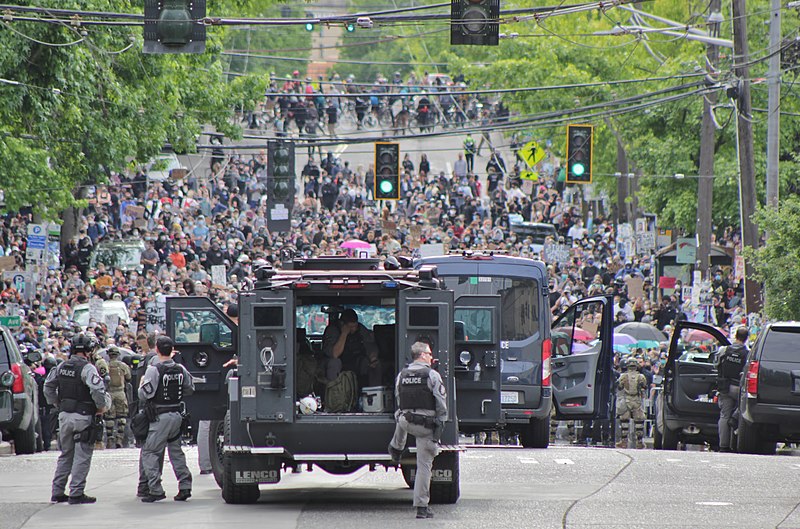If you’re unable to participate in a Black Lives Matter protest, or don’t feel safe joining one, there are other ways you can show support too, like buying from places that are fighting for social justice.
The brutal death of the innocent George Floyd, at the hands of the police, have sparked Black Lives Matter protests all over United States. People are taking to the streets to vocalize against policy brutality and systematic racism. Chances are, you too may be thinking of attending a protest, aren’t you?
If you’re planning to be a part of one, then be aware: your phone is a treasure trove of information regarding you and the individuals you communicate with. At the same time, it functions as a tracking device. Therefore, when planning to protest, you need to minimize your digital footprint.
Any evidence placing you at a protest could possibly get you arrested. Your phone could also get broken, lost, or stolen. Not to mention, there is even a risk of your smartphone being confiscated by authorities, which could give them access to information about “who’s doing the organizing of such protests.”
You need to prepare for the worst, especially considering recent events, and if you’re an avid part of the BLM protests. The steps listed in this guide are a basic start towards protecting your privacy when attending a protest. While they aren’t 100% foolproof, they do offer increased security!
Leave Your Phone at Home and Get a Burner
Smartphones carry a lot of personal information about you. Upon taking it to different locations, it can reveal a detailed log of your activities online, demonstrations or protests you’ve attended, where you work, and where you live. For instance, if you open Instagram or Twitter at a protest, your social media account directly gets tied to the protest.
It’s a good option to just not carry that data with you. Instead, if you can spare around $20 or less, opt for using a burner (disposable) phone, and only turn it on at the site of the protest. Try to remember a few important numbers you may need to call, if something goes wrong. And, make sure to give them your number too, so that they can call, if needed.
Back Up All Data Before Attending the Protest
If you still opt to take your personal phone with you, it is a good strategy to back up all your data. Consider it like conducting a regular device maintenance. If at the protest, things get bad, you can simply erase all your data and protect yourself. Most of the data deleted can also be recovered later.

It is important though to show caution with cloud backups. While yes, they’re a convenient method for backing up your data, the Electronic Frontier Foundation reveals that cybercriminals and malicious entities could still access your information through them, and even put your old data at risk.
Encrypt Your Phone for Maximum Privacy
It’s always a good idea to employ encryption on your personal smartphones. In the event your phone is lost, stolen, or confiscated, you don’t want any information regarding you and other protestors to fall into the hands of the authorities. Luckily, Android and iOS devices both now have built-in data encryption.
On Android, follow these steps. Go to Settings > Security & Location > Advanced > Encryption & Credentials > Tap “Encrypt” phone. For iPhone, the process involves “Turning Passcode on”. Once done, go to the “Touch ID & Passcode menu and scroll to the bottom. Enable “Data Protection”.
This covers the data within your phone, but what about the data being exchanged online? This is where VPNs come in handy. To further receive maximum security, a VPN will shift your location and make it appear as if you reside somewhere else. You can get a reasonably priced one from the cheapest VPN list.
Use a Strong Password, Instead of Biometric Verification
Although a federal judge did rule that police cannot force you to unlock your phone using your fingerprints, eyes, or face, it is still good to be on the safe side. Therefore, turn off any biometric authentication methods when you’re protesting, and instead opt for a strong password or PIN.
As an additional security measure, consider adjusting your settings to avoid seeing messages in notification, when the phone is locked. At the protest, avoid unblocking your phone, unless it is absolutely necessary. If you are taking photos/videos, access the camera, without unblocking your phone.
Opt for Secure Apps to Communicate
If you are using your own phone or a burner, it is still a good idea to use secure apps only. The Electronic Frontier Foundation has provided a list of recommended tools for keeping your phone secure. You can try one of these and see which suits you and your friends attending the protest, best.
For instance, one of the top and most used apps for protestors is “Signal” – a secure, open-source, end-to-end encrypted messaging application that does not store any kind of message metadata. If you’re communicating about protests, then it is the ultimate app to use.
Wrapping Things Up
Aside from tracking your phones, authorities are indulging in other surveillance activities at protests. These also include facial recognition tech. Therefore, try covering your face as much as possible, hide your hair under a hat, or consider wearing protective gear. Make sure to cover up any distinctive marks, such as scars, tattoos, and birthmarks.
If you’re unable to participate in a Black Lives Matter protest, or don’t feel safe joining one, there are other ways you can show support too, like buying from places that are fighting for social justice. If you decide to join protests, consider checking out these resources from activists as well.


Join the conversation!